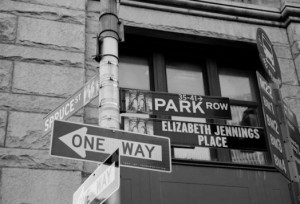 She was the “Rosa Parks” before Rosa Parks.
She was the “Rosa Parks” before Rosa Parks.
As we celebrate Black History Month it is important that stories of African-American heritage continue to be passed along. The countless historic moments that have built the legacy of a surviving race are narratives that need be forever told. But in a modern day society where organic dialogue is minimized to a text message conversation discussing last night’s reality TV show, stories of much greater significance and educational value remain untold. One such story is that of Elizabeth Jennings.
Elizabeth Jennings was a young black schoolteacher who refused to disembark a public railroad car operated by a white conductor, just as Rosa Parks refused to give up her seat on the bus in 1955. Only Jennings stood her ground 100 years before Mrs. Parks conquered her brave moment. That’s almost 200 years ago to the date. Yesterday, Mrs. Parks would’ve reached 101 years of age.
On July 16, 1854 in New York City, a 24-year-old Jennings began her journey to the First Colored Congregational Church on Sixth Street where she was to perform as the organist. Running late, Jennings boarded a streetcar that did not bear the sign “Colored Persons Allowed.” Consequently, her admission onto the Third Avenue Railroad Company streetcar was left to the discretion of the driver. Here’s how the New York Tribune reported the Jennings incident in a February 1855 article:
“She got upon one of the Company’s cars last summer, on the Sabbath, to ride to church. The conductor undertook to get her off, first alleging the car was full; when that was shown to be false, he pretended the other passengers were displeased at her presence; but (when) she insisted on her rights, he took hold of her by force to expel her. She resisted. The conductor got her down on the platform, jammed her bonnet, soiled her dress and injured her person. Quite a crowd gathered, but she effectually resisted. Finally, after the car had gone on further, with the aid of a policeman they succeeded in removing her.”
For what would be another stride towards gaining civil rights, the African-American community rallied at the church the next day and a letter Jennings wrote detailing the fiasco was read. She wrote:
“I told him [Moss] I was a respectable person, born and raised in this city, that I did not know where he was from and that he was a good for nothing impudent fellow for insulting decent persons while on their way to church. Then the (police) officer without listening to anything I had to say thrust me out and tauntingly told me to get redress if I could. I would have come up [to the rally] myself but I’m quite sore & stiff from the treatment I received from those monsters.” – Elizabeth Jennings
Not to be denied of her personal freedoms and proper justice, Jennings sued the company, the driver, and the conductor. The law firm that represented her comprised a talented team that included a then a novice 21-year-old lawyer and future President of the United States, Chester A. Arthur. Jennings would go on to win the case and African-Americans ultimately were able to ride public transportation on an equal basis. In 1855 a Brooklyn judge ruled that:
“Colored persons if sober, well behaved and free from disease, had the same rights as others and could neither be excluded by any rules of the Company, nor by force or violence.” – Judge Rockwell of the Brooklyn Circuit Court
Though the ruling was in her favor, Jennings received only $225 for the injuries she suffered, an amount less that half of what she originally claimed. Nonetheless, her fight was won and her mark in African-American history and history period, was made.
Jennings died in 1901 but it wasn’t until 2007 that her name was officially rooted onto the streets of NYC. A group of 3rd and 4th grade students from P.S.361 on the Lower East Side led a cause that called for a special placard to honor the civil rights figure. And now seven years later, on a pole at the corner of Park Row and Spruce Street, rests a street sign that reads “Elizabeth Jennings Place,” right alongside a bus stop where people of all color are allowed to ride.
She took a stand so that we could all sit, equally, peacefully, and as a people. To that we salute Elizabeth Jennings. Read and pass along.
Mario López (@M5Motie)


